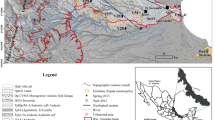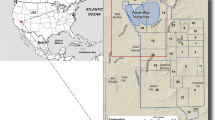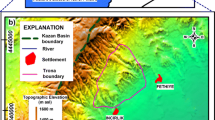Abstract.
Multiple geochemical tracers [ion chemistry, stable isotopes of water, chlorofluorocarbons (CFC), tritium] and a 25-year-long record of discharge were used to understand residence times and flow paths of groundwater seeps in the fractured rock aquifer surrounding the Mission Tunnel, Santa Barbara, California. Tritium data from individual seeps indicate that seep waters are a mixture of >45-year-old (recharged prior to the nuclear bomb tests) and young groundwater. CFC data support this interpretation, however, a two-end member mixing model cannot completely explain the age tracer data. Microbial degradation and partial re-equilibration complicate the CFC signal. Spectral analysis of precipitation and groundwater seepage records shows that seepage lags precipitation by 3 months. This delay is related to the advancement of the wetting front and increasing the number of active flow paths. Additionally, the amount of seepage produced by precipitation is less during extended periods of drought than during normal or wet periods, suggesting antecedent conditions strongly affect flow through this fractured rock aquifer.
Similar content being viewed by others
Author information
Authors and Affiliations
Additional information
Electronic Publication
Rights and permissions
About this article
Cite this article
Rademacher, L.K., Clark, J.F. & Boles, J.R. Groundwater residence times and flow paths in fractured rock determined using environmental tracers in the Mission Tunnel; Santa Barbara County, California, USA. Env Geol 43, 557–567 (2003). https://doi.org/10.1007/s00254-002-0680-2
Received:
Accepted:
Issue Date:
DOI: https://doi.org/10.1007/s00254-002-0680-2




